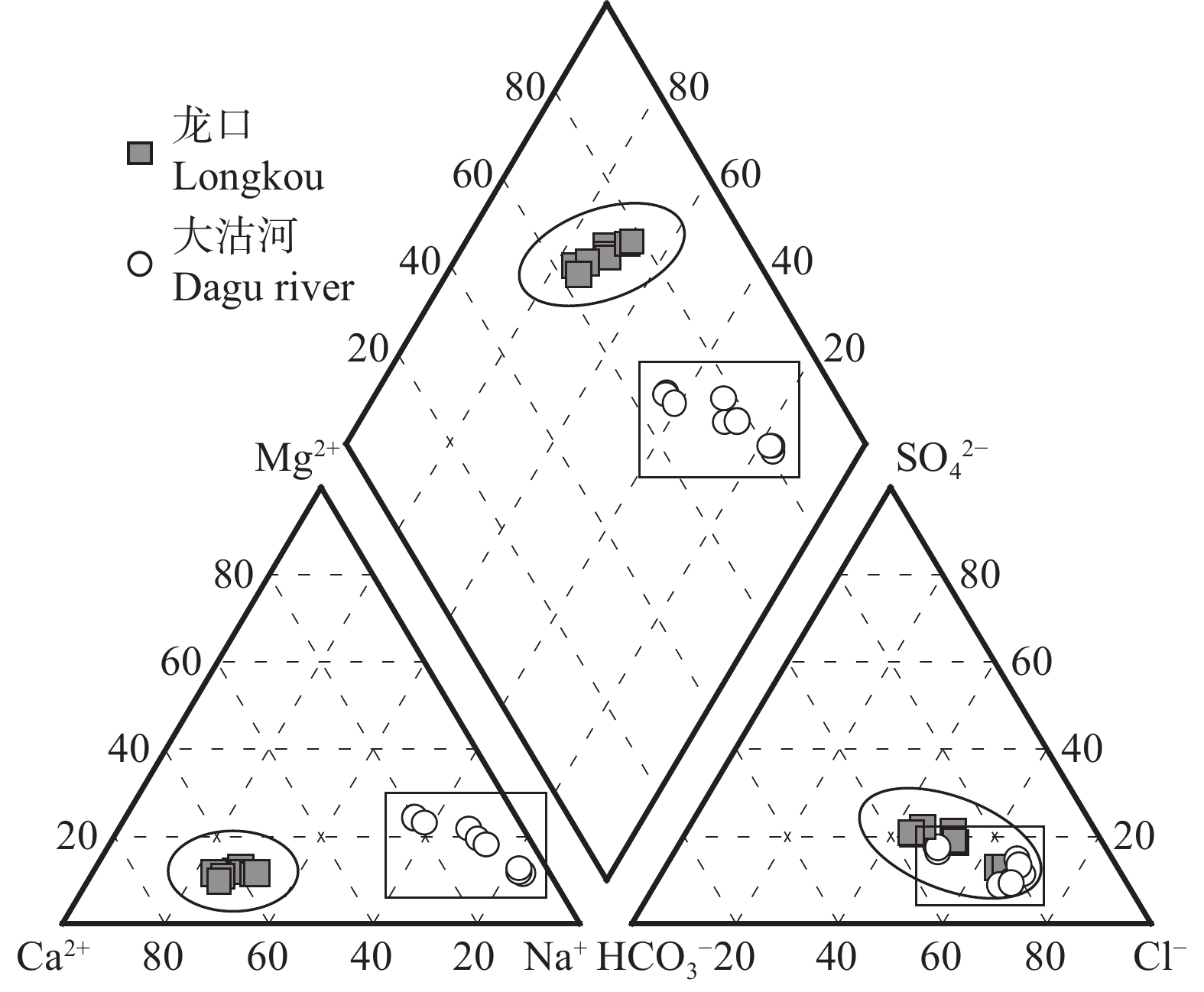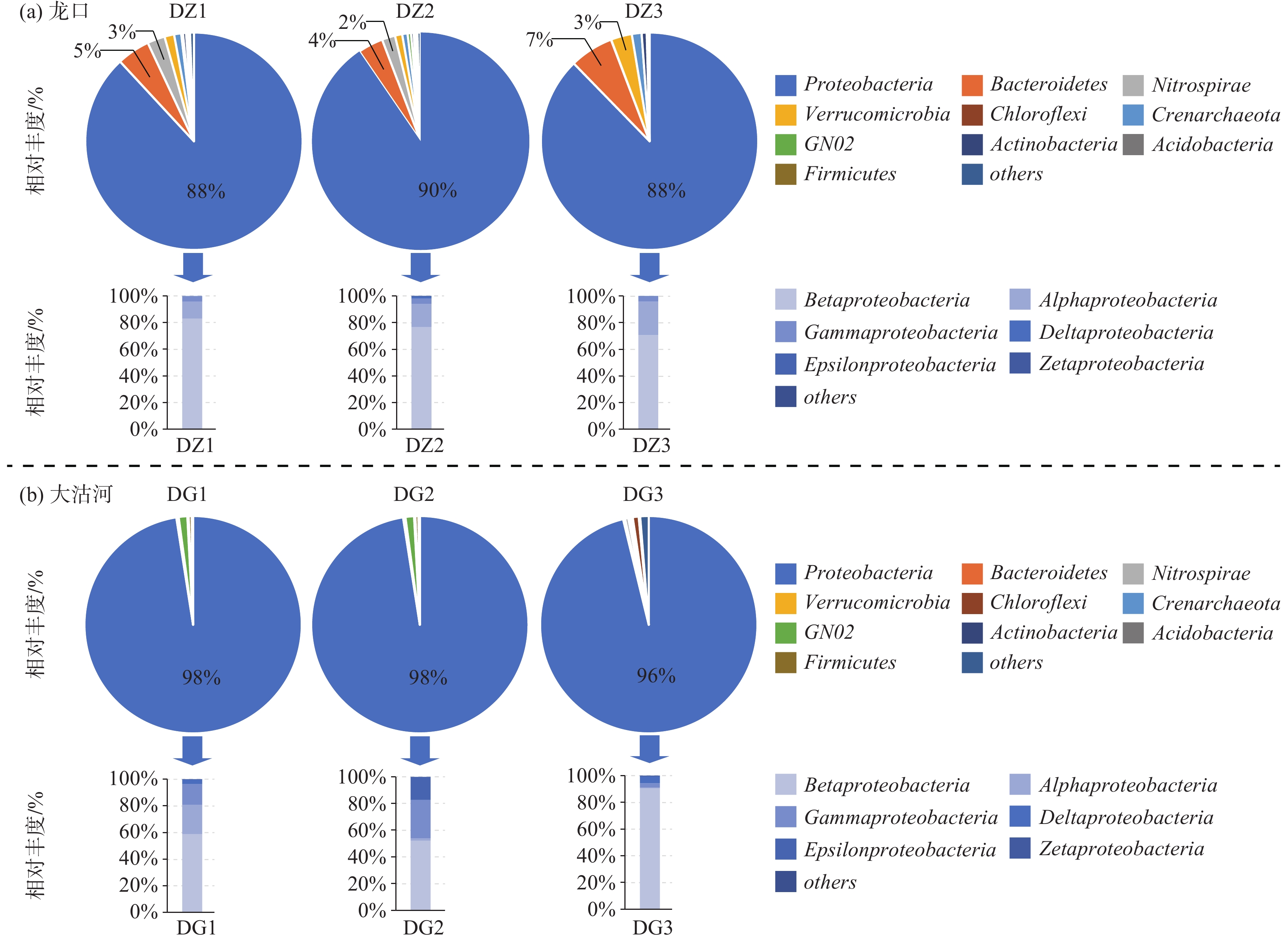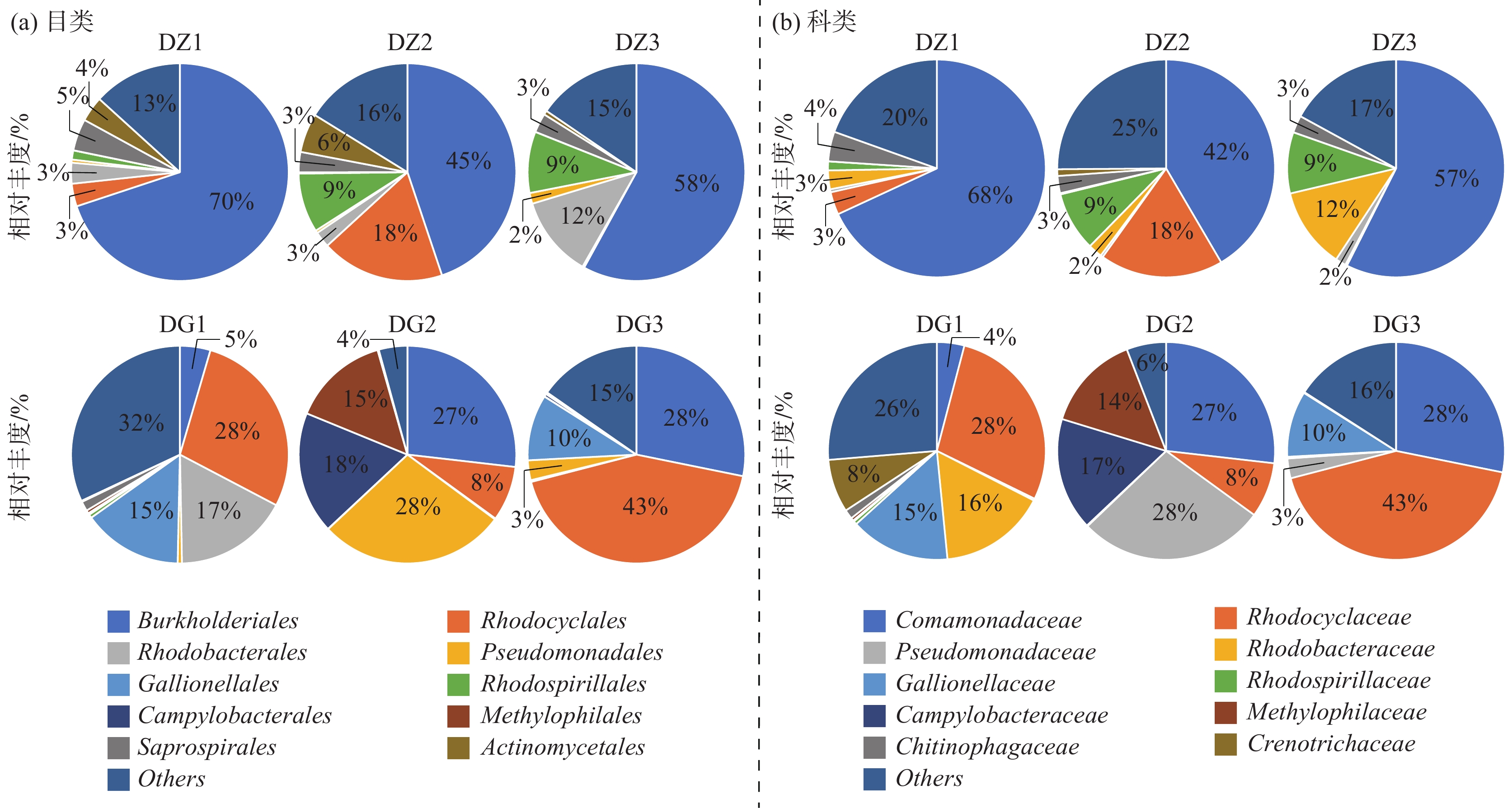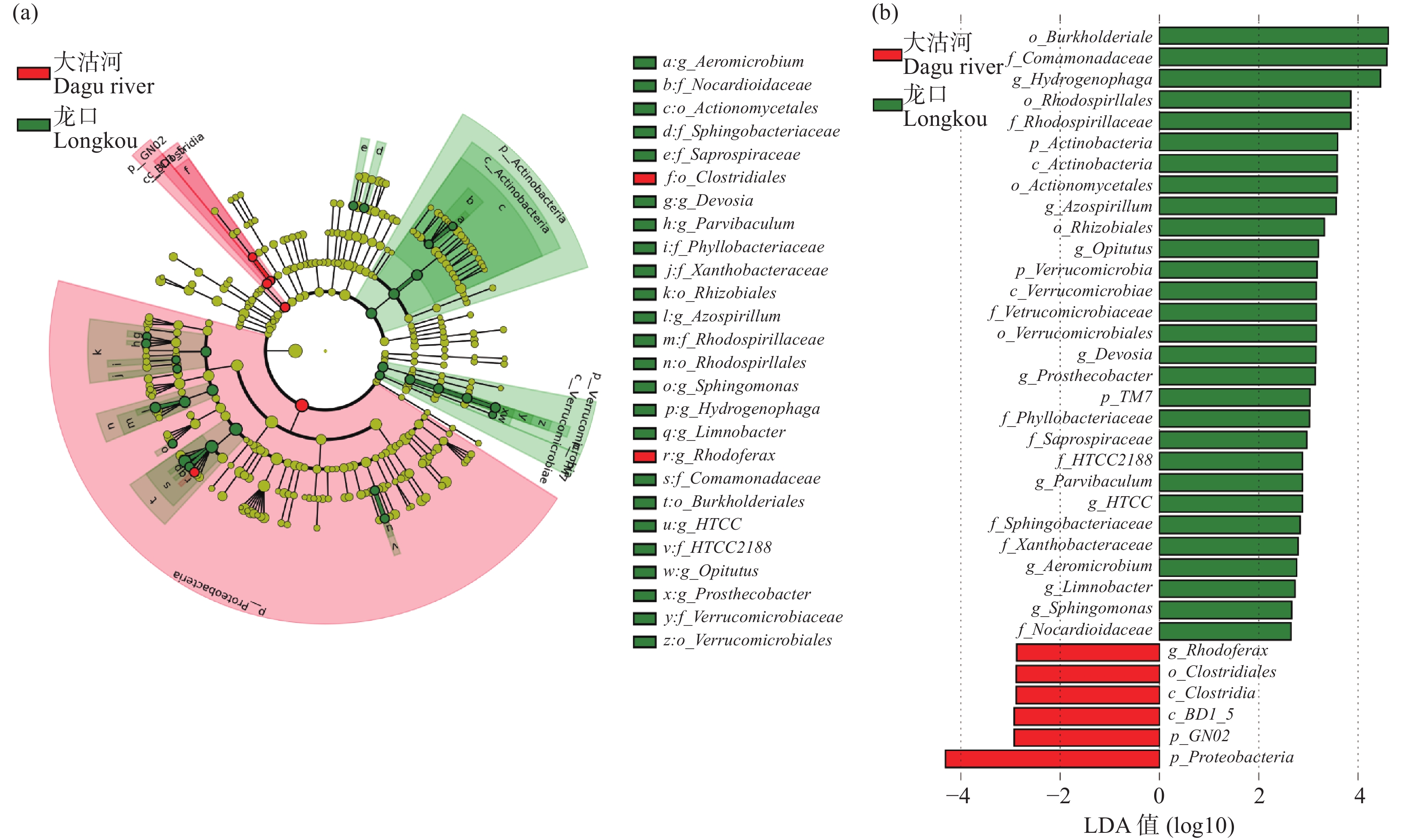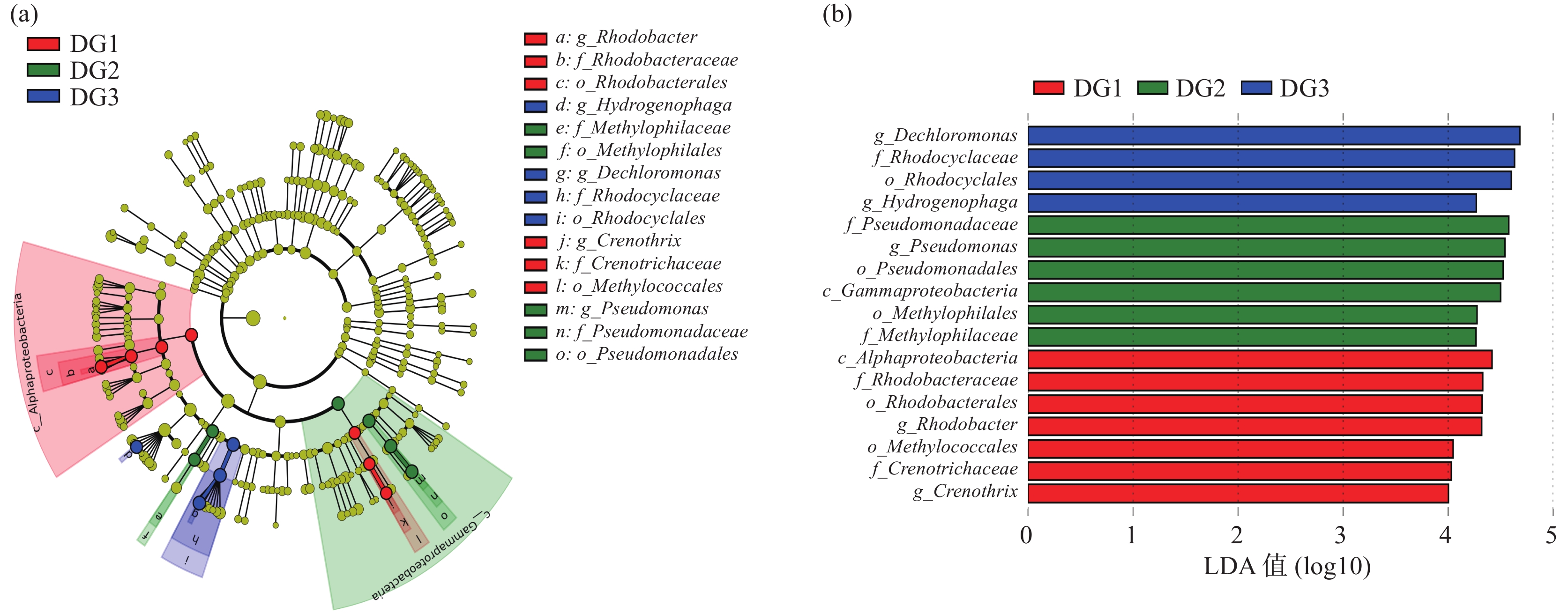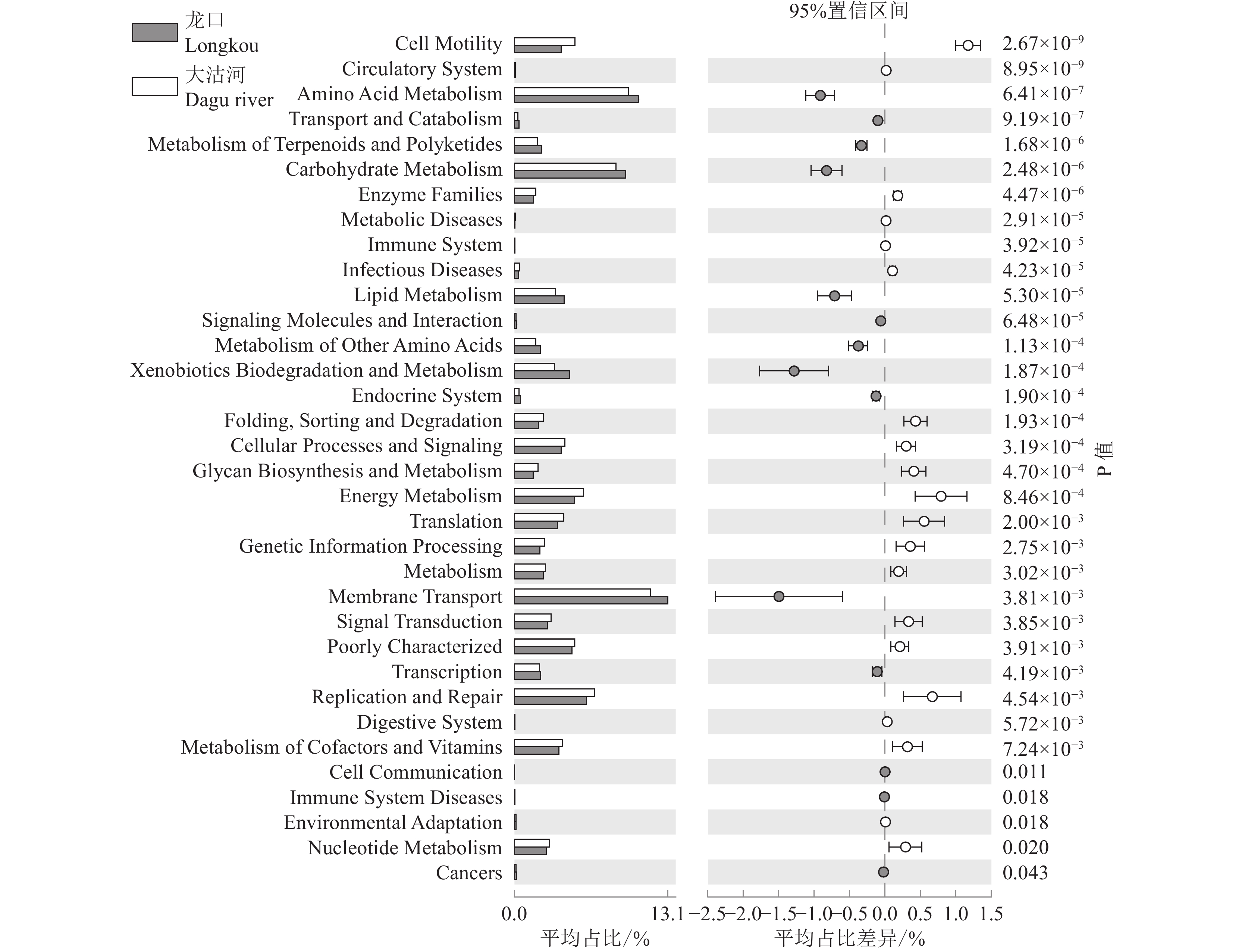Difference study on microbial community structure and diversity of groundwater in different coastal zones
-
摘要:
研究目的 海水入侵已成为全球沿海地区面临的重大环境地质问题及研究热点,探究海水入侵区地下水微生物群落特征可以对海水入侵的管理与防治起到支撑作用。
研究方法 本研究选取黄渤海地区两个典型海岸带(烟台龙口西海岸及青岛大沽河海岸),基于高通量测序方法对当地地下水微生物进行16S rDNA分析,对比海水入侵程度不同的海岸带地下水微生物群落结构与多样性特征差异。
研究结果 大沽河研究区相比龙口研究区地下水受海水入侵的影响更为严重,地下水TDS含量在1.06~3.19 g/L,以Na–Cl–HCO3和Na–Cl型水为主,而龙口研究区地下水TDS相对较低,以Ca–Na–Cl–HCO3型水为主。Alpha多样性指数表明,龙口研究区地下水微生物的均匀度和丰富度随着海水入侵程度的增强而减小,而大沽河研究区地下水微生物多样性变化复杂。龙口研究区三个监测点地下水微生物群落结构相似,而大沽河研究区的微生物群落结构差异较大。龙口研究区标志微生物为伯克霍尔德氏菌目(Burkholderiales),丛毛单胞菌科(Comamonadaceae)和噬氢菌属(Hydrogenophaga);大沽河研究区标志微生物较少,在阈值St≥4.0时标志微生物仅为变形菌门(Proteobacteria)。龙口研究区地下水TOC和DO与微生物丰度呈现正相关关系;而大沽河研究区中,Na+、Cl–、SO42–等指标与微生物丰度呈显著负相关关系,这与当地受海水入侵时间较长有关。
结论 本研究揭示了在不同程度的海水入侵影响下地下水微生物与环境的响应特征,并表现出了不同的标志微生物,表明微生物指标可作为识别海水入侵的新型有效方法。
Abstract:This paper is the result of environmental geological survey engineering.
Objective Seawater intrusion has become a major environmental and geological problem as well as research hotspot in coastal areas all over the world. To explore the characteristics of groundwater microbial communities in coastal areas can play a fundamental role in the management and prevention of seawater intrusion.
Methods This study took two typical costal zones in Yellow Sea and Bohai Sea such as Longkou west bank and Dagu river coast. The microbial 16S rDNA of groundwater was analyzed by high–throughput sequencing method, to explore the diversity and structure characteristics of groundwater microbial communitiesin different areas.
Results The groundwater in Dagu river study area was more seriously affected by seawater intrusion than that in Longkou. In Dagu river study area, the TDS concentration of groundwater was 1.06−3.19 g/L, mainly Na–Cl–HCO3 and Na–Cl type water. In Longkou study area, the TDS of groundwater was relatively low, mainly Ca–Na–Cl–HCO3 type water. The Alpha diversity index showed that the microbial uniformity and richness of groundwater decreased with the increasing seawater intrusion in Longkou, while the variation of microbial diversity of groundwater in Dagu river study area was complex. The groundwater microbial community structures of three monitoring wells in Longkou study area were similar, but the groundwater microbial community structures in Dagu river study area were different. The representative microorganisms of groundwater in Longkou were Burkholderiales, Comamonadaceae and Hydrogenophaga. In Dagu river study area, the representative microorganisms of groundwater are a little, only Proteobacteria was identified at the threshold St≥4.0. TOC and DO were positively correlated with bacterial abundance in groundwater in Longkou study area. In the Dagu river study area, Na+, Cl–, SO42– and other indicators were negatively correlated with bacterial abundance in groundwater, which was related to the long period of seawater intrusion.
Conclusions This study revealed the response characteristics of groundwater microorganisms and the environment under the influence of seawater intrusion at different degrees, and showed different representative microorganisms, indicating that microbial indicators can be used as a new and effective method to identify seawater intrusion.
-

-
表 1 龙口和大沽河研究区地下水样品物化指标
Table 1. Physico–chemical parameters of groundwater samples of Longkou and Dagu river study areas
物化指标 龙口 大沽河 DZ1 DZ2 DZ3 DG1 DG2 DG3 GL/m –3.31 –2.91 –1.89 –0.52 –0.40 –0.69 T/℃ 16.51 17.08 16.60 18.97 18.74 19.50 pH 7.62 7.30 7.35 7.61 7.68 7.54 TOC/(mg/L) 1.70 1.80 1.70 1.80 2.50 2.80 EC/(mS/cm) 1.37 1.82 2.52 1.45 4.13 4.40 TDS/(g/L) 0.68 0.91 1.26 1.06 3.05 3.19 ORP/mV 13.00 21.00 6.00 72.00 49.00 –59.00 DO/(mg/L) 5.28 4.38 4.40 6.28 6.05 2.10 Cl–/(mg/L) 173.08 311.79 604.26 279.15 1314.62 1408.37 HCO3–/(mg/L) 246.01 289.27 376.42 311.71 616.20 787.62 NO3–/(mg/L) 286.01 98.34 153.07 1.08 1.14 32.73 SO42–/(mg/L) 114.09 178.80 167.22 135.74 299.03 269.80 Ca2+/(mg/L) 198.20 208.62 284.48 52.02 50.43 75.18 Na+/(mg/L) 81.00 106.37 174.50 188.03 886.81 676.60 Mg2+/(mg/L) 22.00 26.74 34.90 40.07 67.59 91.07 K+/(mg/L) 2.10 3.08 3.24 23.40 48.04 45.84 注:GL—潜水地下水位;TOC—总有机碳;EC—电导率;TDS—总溶解固体;ORP—氧化还原电位;DO—溶解氧。 表 2 龙口与大沽河研究区地下水样品的微生物群落Alpha多样性指标
Table 2. Microbial community Alpha diversity indices for the groundwater samples of Longkou and Dagu river study areas
多样性指标 龙口 大沽河 DZ1 DZ2 DZ3 DG1 DG2 DG3 Shannon 4.49 4.75 3.46 4.54 4.48 4.20 Chao1 706 573 701 728 338 572 Observed species 239 200 179 218 131 190 PD 17.0 17.0 14.2 20.6 9.4 15.9 表 3 龙口和大沽河研究区地下水微生物丰度与环境因子回归分析
Table 3. Regression analysis of microbial richness and environmental factors in Longkou and Dagu river study areas
物化指标 龙口 大沽河 回归方程 R2 P 回归方程 R2 P GL y=−0.00654x+0.69245 0.079 0.463 y=7.91×10−6x²−0.0075x+1.126 0.658 < 0.05* T y=18.7x−0.0181 0.004 0.864 y=17.8x0.0118 0.044 0.589 pH y=0.00159x+6.6094 0.099 0.410 y=3.83×10−6x²−0.0037x+8.425 0.817 < 0.01** TOC y=3.98×10−5x1.72 0.530 < 0.05* y=−2.25×10−5x²+0.0203x−2.0486 0.256 0.411 EC y=−6.0932x+5080.9 0.097 0.415 y=−0.04561x²+32.549x−1479.7 0.908 < 0.01** TDS y=−3.1274x+2578.8 0.107 0.391 y=−0.03122x²+21.672x−597.56 0.905 < 0.01** ORP y=−0.00475x²+4.9775x−1286.9 0.097 0.415 y=0.00399x²−3.4867x−714.53 0.642 < 0.05* DO y=0.01107x−0.91302 0.507 < 0.05* y=0.00036x²−0.2680x+52.943 0.902 < 0.01** Cl– y=−2.0873x+1454.8 0.087 0.442 y=−3.5751x+2545.5 0.792 < 0.01** HCO3– y=−0.7111x+673.06 0.111 0.380 y=−0.00886x²+6.966x−650.11 0.835 < 0.01** NO3– y=0.86755x−276.62 0.102 0.401 y=−0.0009x²+0.811x−159.45 0.648 < 0.05* SO42– y=−0.4688x+395.58 0.224 0.198 y=−0.7276x+567.62 0.887 < 0.01** Ca2+ y=35468x−0.807 0.047 0.576 y=−0.00088x²+0.7918x−100.75 0.554 0.089 Na+ y=−0.3520x+306.59 0.053 0.550 y=−2.4546x+1671.8 0.949 < 0.01** Mg2+ y=−0.0731x+65.035 0.089 0.435 y=−0.00142x²+1.1802x−151 0.762 < 0.05* K+ y=5528x−1.2 0.164 0.280 y=−0.00044x²+0.3235x−9.36 0.847 < 0.01** 注:**表示显著相关(P<0.01);*表示相关(P<0.05)。 -
[1] Ahn J, Kim W S, Park J B, Francis A J, Um W. 2019. Temporal changes of geochemistry and microbial community in low and intermediate level waste (LILW) repository, South Korea[J]. Annals of Nuclear Energy, 128: 309−317. doi: 10.1016/j.anucene.2019.01.029
[2] Chen L, Hu Bill X, Dai H, Zhang X Y, Xia C A, Zhang J. 2019. Characterizing microbial diversity and community composition of groundwater in a salt–freshwater transition zone[J]. Science of the Total Environment, 678: 574−584. doi: 10.1016/j.scitotenv.2019.05.017
[3] Chen L, Zhang J, Dai H, Hu Bill X, Tong J X, Gui D W, Zhang X Y, Xia C A. 2020. Comparison of the groundwater microbial community in a salt–freshwater mixing zone during the dry and wet seasons[J]. Journal of Environmental Management, 271: 110969. doi: 10.1016/j.jenvman.2020.110969
[4] Gai X, Li S C, Zhang X P, Bian F Y, Yang C B, Zhong Z K. 2021. Changes in soil phosphorus availability and associated microbial properties after chicken farming in Lei bamboo (Phyllostachys praecox) forest ecosystems[J]. Land Degradation & Development, 32(10): 3008−3022.
[5] Gao M S, Guo F, Huang X Y, Hou G H. 2019. Sediment distribution and provenance since Late Pleistocene in Laizhou Bay, Bohai Sea, China[J]. China Geology, 2(1): 16−25. doi: 10.31035/cg2018062
[6] Gilbert J A, Field D, Swift P, Newbold L, Oliver A, Smyth T, Somerfield P J, Huse S, Joint I. 2009. The seasonal structure of microbial communities in the Western English Channel[J]. Environmental Microbiology, 11(12): 3132−3139. doi: 10.1111/j.1462-2920.2009.02017.x
[7] He L Y, He L K, Liu Y S, Zhang M, Zhao J L, Zhang Q Q, Ying G G. 2019. Microbial diversity and antibiotic resistome in swine farm environments[J]. Science of the Total Environment, 685: 197−207. doi: 10.1016/j.scitotenv.2019.05.369
[8] Huang Yi, Huang Muke, Chai Liwei, Zhao Yanran. 2018. Drivers of the spatial patterns of soil microbial communities in aridand semi–arid regions[J]. Ecology and Environmental Sciences, 27(1): 191−198 (in Chinese with English abstract).
[9] Li Xuanyu. 2020. Forecast of influence of future climate change on degree of seawater intrusion in Dandong City[J]. Heilongjiang Hydraulic Science and Technology, 48(10): 59−64 (in Chinese with English abstract).
[10] Liu K, Jiao J J, Gu J D. 2014. Investigation on bacterial community and diversity in the multilayer aquifer–aquitard system of the Pearl River Delta, China[J]. Ecotoxicology, 23(10): 2041−2052. doi: 10.1007/s10646-014-1311-x
[11] Liu Xinzhan, He Jizheng, Zhang Limei. 2009. The sulfate–reducing bacteria and surfer cycle in paddy soil[J]. Acta Ecologica Sinica, 29(8): 4455−4463 (in Chinese with English abstract).
[12] Lozupone C A, Knight R. 2008. Species divergence and the measurement of microbial diversity[J]. Fems Microbiology Reviews, 32(4): 557−578. doi: 10.1111/j.1574-6976.2008.00111.x
[13] Lu Dan, Lei Jing, Wei YanYan, Shen Fangke, Huang Yanfei, Gu Minghua. 2015. Effect of microbial community and diversity index of paddy soil under short no–tillage and ridge tillage[J]. Southwest China Journal of Agricultural Sciences, 28(4): 1670−1674 (in Chinese with English abstract).
[14] Marcus A H, Julian I, Carola M, Andreas S, Georg A, Harold L D. 2005. Dechloromonas denitrificans sp. nov., Flavobacterium denitrificans sp. nov., Paenibacillus anaericanus sp. nov. and Paenibacillus terrae strain MH72, N2O–producing bacteria isolated from the gut of the earthworm Aporrectodea caliginosa[J]. International Journal of Systematic and Evolutionary Microbiology, 55: 1255–1265.
[15] Qu M W, Liu Y, Hao M Q, Wang M T, Chen R, Wang X C C, Zheng Y C, Dzakpasu M. 2022. Microbial community and carbon–nitrogen metabolism pathways in integrated vertical flow constructed wetlands treating wastewater containing antibiotics[J]. Bioresource Technology, 354: 127217. doi: 10.1016/j.biortech.2022.127217
[16] Rocca J D, Simonin M, Bernhardt E S, Washburne A D, Wright J P, Ecology J. 2019. Rare microbial taxa emerge when communities collide: freshwater and marine microbiome responses to experimental mixing[J]. Ecology, 101(3): e02956.
[17] Sharp J H, Yoshiyama K, Parker A E, Schwartz M C, Curless S E, Beauregard A Y, OssolinskiJ E, Davis A R. 2009. A biogeochemical view of estuarine eutrophication: Seasonal and spatial trends and correlations in the Delaware Estuary[J]. Estuaries & Coasts, 32(6): 1023−1043.
[18] Shen L J, Nuchit S. 2020. The characteristics, formation and exploration progress of the potash deposits on the Khorat Plateau, Thailand and Laos, Southeast Asia[J]. China Geology, 3(1): 67−82. doi: 10.31035/cg2020009
[19] Shi W L, Lu C H, Werner A D. 2020. Assessment of the impact of sea–level rise on seawater intrusion in sloping confined coastal aquifers[J]. Journal of Hydrology, 586: 124872. doi: 10.1016/j.jhydrol.2020.124872
[20] Sun Jinhua, Wu Yongxiang, Lin Jing, Zhong Huaping, Li Wei, Han Jiangbo, Li Daiyuan. 2021. Seawater intrusion prevention and groundwater management and study in the coastal area of the Yellow Sea and the Bohai Sea[J]. China Water Resources, 7: 20−23 (in Chinese with English abstract).
[21] Telesh I V, Khlebovich V V. 2010. Principal processes within the estuarine salinity gradient: A review[J]. Marine Pollution Bulletin, 61(4−6): 149−155. doi: 10.1016/j.marpolbul.2010.02.008
[22] Unno T, Kim J, Kim Y, Nguyen S, Guevarra R B, Kim G P, Lee J H, Sadowsky M J. 2015. Influence of seawater intrusion on microbial communities in groundwater[J]. Science of the Total Environment, 532: 337−343. doi: 10.1016/j.scitotenv.2015.05.111
[23] Valenzuela–Madrigal I E, Valenzuela–Quinonez W, Esparza–Leal H M, Rodriguez–Quiroz G, Aragon–Noriega E A. 2017. Effects of ionic composition on growth and survival of white shrimp Litopenaeus vannamei culture at low–salinity well water[J]. Revista de Biologia Marina y Oceanografia, 52(1): 103−112. doi: 10.4067/S0718-19572017000100008
[24] Wang Hui, Xu Xuegong. 2016. Evaluation of carrying capacity of water resources under the pressure of seawater intrusion in Laizhou, Shandong Province[J]. China Rural Water and Hydropower, 6: 43−46, 50 (in Chinese with English abstract).
[25] Wang L, Zhang J, Li H L, Yang H, Peng C, Peng Z S, Lu L. 2018. Shift in the microbial community composition of surface water and sediment along an urban river[J]. Science of the Total Environment, 627: 600−612. doi: 10.1016/j.scitotenv.2018.01.203
[26] Wang Yanxin, Gan Yiqun, Deng Yamin, Xie Xianjun. 2020. Land–ocean interactions and their eco–environmental effects in the coastal zone: Current progress and future perspectives[J]. Bulletin of Geological Science and Technology, 39(1): 1−10 (in Chinese with English abstract).
[27] Wook C B, Dae L B, Yun U, Clm H C. 2003. Study on the possibility of seawater intrusion in the Ulsan Area using Br : Cl weight ratios of groundwater[J]. Economic and Environmental Geology, 36(5): 339–347.
[28] Wu Jichun, Xue Yuqun, Xie Chunhong, Zhang Zhihui. 1996. Cations exchange between water and soilin the process of seawater intrusion[J]. Hydrogeology & Engineering Geology, (3): 18−19 (in Chinese with English abstract).
[29] Wu Jichun, Wu Yongxiang, Lin Jin, Han Jiangbo. 2018. Study on the groundwater management and seawater intrusion prevention in the coastal areas of the Bohai Sea and the Yellow Sea[J]. Chinese Journal of Environmental Management, 10(2): 91−92 (in Chinese with English abstract).
[30] Xia Jun, Li Miao, Li Fulin, Liu Jian, Meng Dejuan. 2013. Effects of sea level rise on seawater intrusion in coastal areas of Shandong Province[J]. Yellow River, 35(9): 1−3 (in Chinese with English abstract).
[31] Xiong Guiyao, Fu Tengfei, Han Jiangbo, Chen Guangquan, Xu Xingyong, Xu Xiuli, Liu Guanqun, Liu Wenquan. 2019. Hydrogeochemical and isotopic characteristics of groundwater in Dagu River Basin[J]. Advances in Marine Science, 37(4): 626−637 (in Chinese with English abstract).
[32] Yang H, Li D, Zeng H P, Zhang J. 2018. Autotrophic nitrogen conversion process and microbial population distribution in biofilter that simultaneously removes Fe, Mn and ammonia from groundwater[J]. International Biodeterioration & Biodegradation, 135: 53−61.
[33] Yang Y F, Gao Y, Wang S P, Xu D P, Yu H, Wu L W, Lin Q Y, Hu Y G, Li X Z, He Z L, Deng Y, Zhou J Z. 2014. The microbial gene diversity along an elevation gradient of the Xizang grassland[J]. The ISME Journal, 8(2): 430−440. doi: 10.1038/ismej.2013.146
[34] Yu J B, Zhou D, Yu M, Yang J S, Li Y Z, Guan B, Wang X H, Zhan C, Wang Z K, Qu F Z. 2021. Environmental threats induced heavy ecological burdens on the coastal zone of the Bohai Sea, China[J]. Science of the Total Environment, 765: 142694. doi: 10.1016/j.scitotenv.2020.142694
[35] Zhang Ni, Chen Kelong, Wang Hengsheng, Yang Yang. 2022. Changes of microbial community characteristics in freezing–thaw degradation of alpine wetland[J]. Ecological Science, 41(2): 20−28 (in Chinese with English abstract).
[36] Zhao Jie, Lin Jin, Wu Jianfeng, Wu Jichun. 2020. Prediction of the impact of future climate change on the extent of seawater intrusion in Zhoushuizi district of Dalian City in northern China[J]. Hydrogeology & Engineering Geology, 47(3): 17−24 (in Chinese with English abstract).
[37] Zhu Ruijie, Zhou Xuejun, Zhan Tao, Ma Yongfa, Wang Xu, Dong Junling, Liu Ling, Yang Fengtian, Li Dong, Shi Yujia, Su Yujuan. 2023. Analysis of microbial diversity and community structure in thermal watersfrom Lindian geothermal field, Heilongjiang Province[J]. Geology in China, 50(6): 1667−1677 (in Chinese with English abstract).
[38] 黄艺, 黄木柯, 柴立伟, 赵嫣然. 2018. 干旱半干旱区土壤微生物空间分布格局的成因[J]. 生态环境学报, 27(1): 191−198.
[39] 李选彧. 2020. 未来气候变化对丹东市海水入侵程度的影响预测[J]. 黑龙江水利科技, 48(10): 59−64. doi: 10.3969/j.issn.1007-7596.2020.10.017
[40] 刘新展, 贺纪正, 张丽梅. 2009. 水稻土中硫酸盐还原微生物研究进展[J]. 生态学报, 29(8): 4455−4463. doi: 10.3321/j.issn:1000-0933.2009.08.053
[41] 路丹, 雷静, 韦燕燕, 沈方科, 黄雁飞, 顾明华. 2015. 短期免耕和垄作对稻田土壤微生物群落及多样性指数的影响[J]. 西南农业学报, 28(4): 1670−1674.
[42] 孙金华, 吴永祥, 林锦, 钟华平, 李伟, 韩江波, 李岱远. 2021. 黄渤海沿海地区海水入侵防治与地下水管理研究[J]. 中国水利, 7: 20−23. doi: 10.3969/j.issn.1000-1123.2021.07.012
[43] 王辉, 许学工. 2016. 海水入侵胁迫下的莱州市水资源承载力评价[J]. 中国农村水利水电, 6: 43−46, 50. doi: 10.3969/j.issn.1007-2284.2016.03.011
[44] 王焰新, 甘义群, 邓娅敏, 谢先军. 2020. 海岸带海陆交互作用过程及其生态环境效应研究进展[J]. 地质科技通报, 39(1): 1−10.
[45] 吴吉春, 吴永祥, 林锦, 韩江波. 2018. 黄渤海沿海地区地下水管理与海水入侵防治研究[J]. 中国环境管理, 10(2): 91−92. doi: 10.3969/j.issn.1674-6252.2018.02.017
[46] 吴吉春, 薛禹群, 谢春红, 张志辉. 1996. 海水入侵过程中水−岩间的阳离子交换[J]. 水文地质工程地质, (3): 18−19.
[47] 夏军, 李淼, 李福林, 刘健, 孟德娟. 2013. 海平面上升对山东省滨海地区海水入侵的影响[J]. 人民黄河, 35(9): 1−3. doi: 10.3969/j.issn.1000-1379.2013.09.001
[48] 熊贵耀, 付腾飞, 韩江波, 陈广泉, 徐兴永, 徐秀丽, 刘贯群, 刘文全. 2019. 大沽河流域地下水水化学及同位素特征[J]. 海洋科学进展, 37(4): 626−637.
[49] 章妮, 陈克龙, 王恒生, 杨阳. 2022. 高寒湿地冻融退化下微生物群落特征变化[J]. 生态科学, 41(2): 20−28.
[50] 赵洁, 林锦, 吴剑锋, 吴吉春. 2020. 未来气候变化对大连周水子地区海水入侵程度的影响预测[J]. 水文地质工程地质, 47(3): 17−24.
[51] 朱瑞杰, 周学军, 詹涛, 马永法, 王旭, 董俊领, 刘玲, 杨峰田, 李栋, 石宇佳, 苏玉娟. 2023. 黑龙江林甸地热田热水微生物多样性与群落结构分析[J]. 中国地质, 50(6): 1667−1677. doi: 10.12029/gc20210602003
-




 下载:
下载:
